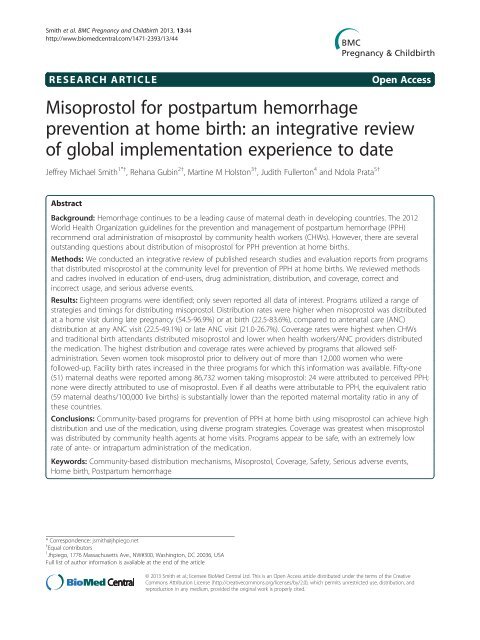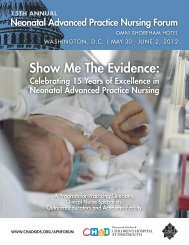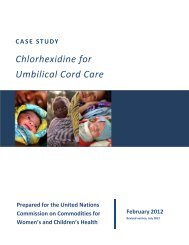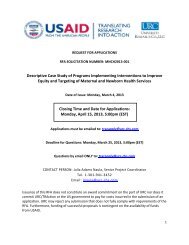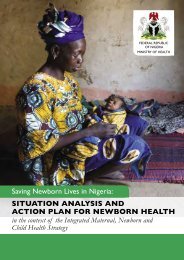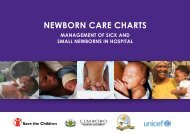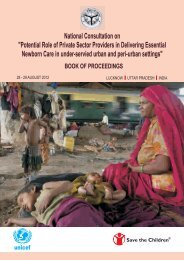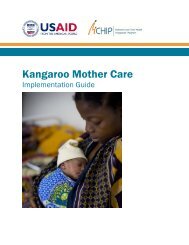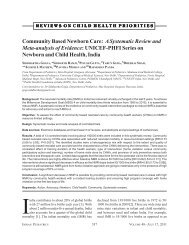Misoprostol for postpartum hemorrhage prevention ... - BioMed Central
Misoprostol for postpartum hemorrhage prevention ... - BioMed Central
Misoprostol for postpartum hemorrhage prevention ... - BioMed Central
You also want an ePaper? Increase the reach of your titles
YUMPU automatically turns print PDFs into web optimized ePapers that Google loves.
Table 2 Characteristics of included programsCountry (* indicatespeer-reviewedreference)Design and scopeHome birth rate (<strong>for</strong> regionor program area, whereavailable; ** indicatesnational rate)Number of womenenrolled (<strong>for</strong> “studies,”number reflectsintervention group only)Number of women takingmisoprostol ( a indicates overall;b indicates number from<strong>postpartum</strong> subsample)Administrationmethod(s)Afghanistan [24]* Study using nonrandomized experimental control design80.1% 2039 1350 1 Selfin 2 districtsBangladesh [33] Operations research project in 6 districts 87% 118,594 enrolled; 77,337delivered, of whom 53,897received CDK 2 46,561 a 1893 b Self and TBABangladesh [14]* 3 Study using quasi-experimental design in 2 districts 85%** 1009 884 CHWBangladesh [34] Pilot project in 1 district 85%** 19,497 9228 SelfEthiopia [13]* Study using quasi-experimental design in 1 area 97% 500 485 TBAGambia [35]* Study using randomized controlled design in 1 district 72% 630 630 TBAGhana [36] Pilot project in 4 districts 37.5% 5345 1261 b SelfIndia [22]* Study using randomized controlled design in 1 district 45.2% 812 809 SBAIndonesia [37] Study using nonrandomized experimental design in 248% 1322 999 SelfdistrictsKenya [38] Pilot project in 2 districts 38.7% 3844 1084 b Self and SBAMozambique [39] Operations research project in 4 districts, with each of 3sites using a different distribution strategy: 1) late ANConly, 2) TBA at birth, 3) a combination of late ANC andTBA at birth35.3% 11,927 4781 b Self and/or TBANepal [23]* Operations research project in 1 district 89.1% 18,761 13,969 a 435 b SelfNigeria [40] Operations research project in 1 state 95% 1875 1421 b TBAPakistan [15]* Study using randomized controlled design in 1 province 65%** 534 533 TBAPakistan [41]* 4 Study using quasi-experimental design in 2 districts 61% 872 678 TBATanzania [42] Operations research project in 4 districts 30.8% 12,511 1826 b SelfZambia [43] Pilot project in 5 districts 59.9% 5574 233 b SelfZambia [44] Pilot project in 10 districts 71% (<strong>for</strong> rural areas)** 31,315 Not reported Self and TBA1 Administration Be<strong>for</strong>e Birth and Adverse Maternal Outcomes were reported <strong>for</strong> all 1421 women in the intervention group who took misoprostol, regardless of the place of delivery, but <strong>for</strong> consistency with otherstudies and programs (and because there was no indication to the contrary), we have assumed, particularly <strong>for</strong> the adverse outcomes reported in Table 6, that any such outcomes occurred only in those 1350 womentaking misoprostol <strong>for</strong> home births.2 <strong>Misoprostol</strong> included in CDK. The kits used by these programs included gloves, soap, a blood loss measurement mat [31,32,45] and other materials recommended <strong>for</strong> use by women who delivered at home.3 Dose of misoprostol used was 400 μg (two tablets).4 <strong>Misoprostol</strong> 600 μg was included in CDK.Smith et al. BMC Pregnancy and Childbirth 2013, 13:44 Page 5 of 11http://www.biomedcentral.com/1471-2393/13/44
Smith et al. BMC Pregnancy and Childbirth 2013, 13:44 Page 6 of 11http://www.biomedcentral.com/1471-2393/13/44document the clinical effect of misoprostol on PPH<strong>prevention</strong>, but, rather, to document the operationaland health-related outcomes of the program’s chosenimplementation methods.All but one of the programs included in this revieweither explicitly mentioned using a dose of 600 μgmisoprostol, which is commonly manufactured as threetablets of 200 μg each, or mentioned using “threetablets” and there<strong>for</strong>e presumably used a dose of600 μg, the WHO currently recommended dosage [46].Oneprogramusedadoseof400μg only[14].Thirteen of the 18 programs described their user educationmethods in their reports. The programs used avariety of strategies to provide in<strong>for</strong>mation, educationand communication to women and their families aboutthe purpose and proper use of misoprostol, includingindividual meetings, group meetings, print media, andradio messages. Most programs emphasized the importanceof delivering in a health facility as one of the keymessages.Nine programs described in<strong>for</strong>mation on stock-outsand methods used to avoid them. All 18 specified thenumber of doses distributed. Accounting methodsincluded periodic meetings among program staff (n = 8;44.4%), stock monitoring by hand count (n = 6; 33.3%),and accounting <strong>for</strong> the voluntary return of unused drugs(n = 3; 16.7%).Tables 3 and 4 depict the various times chosen byprograms to distribute misoprostol to women, the cadresused to distribute the drug, and the individual(s) whoadministered the drug. Four of 18 programs (22.2%)distributed the drug earlier than 28 weeks of pregnancy.Nine programs distributed misoprostol at the time ofhome birth, two of which included the medication inclean delivery kits (CDKs) [45].Health workers (including ANC providers) and TBAswere the most common distributors of the medication(7 programs each). Six programs used CHWs, and twoused “other” community health personnel, such as familyplanning field workers or community drug keepers, inthe distribution ef<strong>for</strong>t.Self-administration (n = 11; 61.1%) and administrationby TBAs (n = 8; 44.4%) were the two most commonmethods used <strong>for</strong> administration of the drug (Table 3).Additional methods included administration by CHWsand skilled or semi-skilled birth attendants.Tables 4 and 5 illustrate the wide variation in the distributionand coverage rates achieved among the 11programs <strong>for</strong> which sufficient in<strong>for</strong>mation was available.Seven programs did not report sufficient in<strong>for</strong>mation toreliably calculate either of these rates. One program inMozambique used three different distribution strategies,resulting in similar distribution rates regardless of whetherTBAs, ANC providers, or both, were the distributingTable 3 Types of misoprostol distribution andadministrationDistribution and administrationfeature (multiple possible)Distribution timingN of programs(total = 18)%ofprogramsAny ANC visit (>12 weeks) 4 22.2Late pregnancy ANC visit (>28 weeks) 3 16.7Late pregnancy home visit5 27.8(28–32 weeks)At home birth 9 50.0Distributing cadreCHW 1 6 33.3TBA 7 3 38.9Health workers 2 /ANC providers 7 38.9Other (family planning field worker, 2 11.1community drug keeper)Administration methodSelf 11 61.1TBA 8 44.4CHW 1 5.6SBA 4 2 16.71 Includes female community health volunteers in Nepal and communitybasedlady health workers in Population Council’s Pakistan program.2 Includes auxiliary nurse midwives in India.3 One program with 99.6% CHW distribution and only 0.4% TBA distributionwas considered to be CHW distribution only.4 This category also includes two types of semi-skilled health workers: auxiliarynurse midwives in India and community midwives in Kenya.cadre(s) (range of 21.0% to 26.7%); however, markedlyhigher coverage rates were achieved with TBAs as the distributingcadre (73.5% compared to 16.2% <strong>for</strong> ANC only).The unexpected similarity in distribution rates might beexplained by the fact that only a sub-sample of womenwith follow-up data was included in the calculations fromANC distribution sites, while the entire sample wasincluded in the calculations from TBA distribution sites.Three programs attempted to assess whether therewas any change in the facility birth rate in the districtsin which misoprostol was distributed <strong>for</strong> home use. InAfghanistan [24] and Zambia [43] comparison betweenthe intervention and control areas showed an increase of3.3% and 13.8%, respectively, in facility birth rates in theintervention areas. In Nepal [23] there was an increaseof 3.9% in the facility birth rates at the end of the intervention,when compared to the beginning.Table 6 presents the occurrence of adverse outcomeswhen misoprostol was used <strong>for</strong> <strong>prevention</strong> of PPH athome birth. Incorrect use of the drug (consumptionbe<strong>for</strong>e the birth) occurred in seven cases across fourprograms, among 12,615 users, <strong>for</strong> an overall rate of0.06%. Many of the programs also reported instanceswhen the drug was incorrectly administered after deliveryof the placenta or if fewer than the required numberof tablets had been taken.
Smith et al. BMC Pregnancy and Childbirth 2013, 13:44 Page 7 of 11http://www.biomedcentral.com/1471-2393/13/44Table 4 Distribution and coverage rates or rate ranges by distribution timing, distributing cadres and administrationmethod (<strong>for</strong> programs <strong>for</strong> which rates were calculable)Distribution or administration feature(multiple possible, and <strong>for</strong> this table, the 3Mozambique strategies are separately reported)DistributiontimingDistributingcadreAdministrationmethodDistribution rateor rate rangeCoverage rateor rate rangeAny ANC visit 22.5–49.1% 16.8–65.9%Late ANC visit 21.0–26.7% 16.2-35.9%Home visit (late pregnancy) 54.5-96.6% 55.7-93.8%At home birth 22.5-83.6% 16.8-73.5%Community health worker 54.5-96.6% 87.9-93.8%Traditional birth attendant 25.9-86.5% 35.9-73.5%Health worker/ ANC provider 21.0-49.1% 16.2-65.9%Other 66.5-83.6% 55.7%Self 21.0-96.6% 16.2-93.8%Traditional birth attendant 25.9-86.5% 35.9-73.5%Community health worker N/A N/ASkilled birth attendant orsemi-skilled health worker22.5% 16.8%A total of 51 maternal deaths were reported amongthe 86,732 women taking misoprostol <strong>for</strong> home birth.A total of 24 of these deaths were attributed toperceived PPH or excessive bleeding. No deaths in the18 programs reviewed were reported to be directlyattributed to use of misoprostol.Program reports mention three cases of suspecteduterine rupture among women who took misoprostolfollowing delivery. The diagnosis cannot be confirmed inany of these cases, given that the maternal auditmethods used by these programs were not described andno autopsy was reported. The incidence of other adverseoutcomes requiring hospital transfer was equal to or lessthan one third of 1% among 17 programs reporting onserious adverse events.DiscussionThis integrative review shows a range of implementationapproaches, data collection procedures, and documentationapproaches in programs <strong>for</strong> <strong>prevention</strong> of PPHat home birth using misoprostol. We recognize thelimitations in comparing programs and drawing summaryconclusions from different implementation models anddata reporting practices, but we believe that a sufficientnumber of community-level misoprostol programs havebeen attempted to date to render discussion and interpretationof their methods and outcomes timely and appropriate.The nature and quality of the data, a majority ofwhich was extracted from non-peer-reviewed projectreports, restricts the statistical methods that could be usedin data analysis, and requires the following caveatsregarding generalizability.The in<strong>for</strong>mation that we sought to retrieve <strong>for</strong> purposesof this integrative review was not necessarily a componentof the program monitoring plans <strong>for</strong> all programs, and,even if collected, was not necessarily reported or reportedin a comparable manner. As a result, there are missing orassumed data <strong>for</strong> some variables of interest. For example,a common definition of PPH as an adverse event was notpresent in all reports, and reports that used the term excessivebleeding were assumed to be referring to perceivedPPH. Explicit mention of PPH was itself absent in onereport.Additionally, this review might be biased toward morefavorable results. In addition to selective data extractionfrom included programs, programs that were excludedfrom this review because of substantial missing data mighthave contained unfavorable results that the implementingorganizations chose not to share with the public, althoughthis is unlikely.It is interesting to note that a substantial number ofprograms did not collect or report sufficient data to estimatetheir distribution or coverage rates. Given thatmisoprostol <strong>for</strong> home birth is a strategy to achievegreater protection from PPH – regardless of location ofbirth – we anticipated that these data would have beenmore readily available.We were particularly cautious in estimating the rates ofdistribution and coverage of misoprostol because weunderstand that most programs were not attempting toreach all pregnant women within an intervention area anddid not follow up with all women who receivedmisoprostol prior to delivery. Estimations were based onavailable data and assumptions regarding population orsample data. The heterogeneity of program methodologies
Smith et al. BMC Pregnancy and Childbirth 2013, 13:44 Page 8 of 11http://www.biomedcentral.com/1471-2393/13/44Table 5 <strong>Misoprostol</strong> distribution and coverage rates(<strong>for</strong> programs reporting)Country Distribution rate (%) Coverage rate (%)Afghanistan [24] 96.6 93.8Bangladesh [34] 66.5 55.7Ghana [36] 49.1 65.9Indonesia [37] 54.5 87.9Kenya [38] 22.5 16.8Mozambique [39] 1TBA only 25.9 73.5ANC only 21.0 16.2TBA and ANC 26.7 35.9Nepal [23] 72.2 Insufficient in<strong>for</strong>mationNigeria [40] 83.6 Insufficient in<strong>for</strong>mationPakistan [41] 86.5 Insufficient in<strong>for</strong>mationTanzania [42] 26.3 29.3Zambia [43] 40.3 Insufficient in<strong>for</strong>mation1 This program had a different distribution strategy at each of three differentsites. To distinguish among approaches, results are presented <strong>for</strong> eachstrategy separately.does not allow <strong>for</strong> the <strong>for</strong>mation of point estimates; there<strong>for</strong>ewe present rate ranges. Footnotes in the tablespresent additional in<strong>for</strong>mation about calculations. Actualdistribution and coverage rates at home births could behigher than those we calculated and reported.We present misoprostol distribution separate from itscoverage because fewer women might consume the drugthan those who receive it. Consumption, or coverage,presents a more accurate measure of program effectivenessthan distribution because it reflects both successfuldistribution as well as effective counseling to the woman,her family, and any involved providers.No particular timing was predominant among programsthat distributed misoprostol prior to birth (n = 12), withprograms using early, late, or unrestricted distributiontiming. However, the range of distribution rates to the targetpopulation of pregnant women was lower <strong>for</strong> lateANC visit distribution compared to distribution at anyANC visit.Programs that allowed distribution by CHWs and duringhome visits achieved greatest distribution and coverage,potentially more than double the coverage achievedby programs with distribution by health workers or as apart of ANC services. Distribution of the drug by othertypes of community-based workers also appeared to allowhigh distribution and coverage rates, in the very fewprograms <strong>for</strong> which this strategy is reported. This suggeststhat home-based distribution approaches, with relativelylow-skilled providers, either singly or combined withfacility-based approaches, can achieve high rates of distributionto the target population. This is potentially due tothe pressures that health workers are under during theirTable 6 Adverse outcomesOutcomesN of occurrences inprograms reporting 1(total # of women takingmisoprostol at homebirths 2 )Frequency (range)Administration7 3 (12,615) 0.06% (0%–0.23%)be<strong>for</strong>e birthMaternal deathsTotal 51 (86,732) 0.06% (0%–1.72%)Deaths due toPPH/excessivebleeding24 (86,732) 0.03% (0.00%–0.16%)Perceived PPH/194 (72,534) 0.3% (0%–8.9%)excessive bleedingOther adverseoutcomesrequiring hospitalreferral 4 27 (86,732) 0.03% (0%–0.3%)1 For Administration Be<strong>for</strong>e Birth and Perceived PPH/Excessive Bleeding, onlythose programs reporting comparable data <strong>for</strong> the specific category havebeen included in the calculation. For Maternal Deaths and other adverseoutcomes requiring hospital referral, because of the severity of theseoutcomes, it has been assumed that if a study or program reported data on atleast one of these outcomes and did not mention other outcomes, the otheroutcomes did not occur.2 Some programs only collected data on these outcomes <strong>for</strong> a subsample ofwomen taking misoprostol <strong>for</strong> home births, as noted in Table 2. TheAdministration Be<strong>for</strong>e Birth total includes subsample numbers if both overalland subsample numbers are available. The Adverse Maternal Outcomes data,however, includes overall numbers wherever available because the presenceof community in<strong>for</strong>mation sources makes it likely that such outcomes wouldbe known and noted <strong>for</strong> the entire home-birth misoprostol population.3 This includes one inferred occurrence from in<strong>for</strong>mation that one woman inthe Ghana program took misoprostol at the incorrect time and not afterdelivery of the placenta.4 Such outcomes were enumerated in 2 programs. In one program, theoutcomes were reported as including “retained placenta, <strong>postpartum</strong>eclampsia, severe lower abdominal pain, and lack of typical <strong>postpartum</strong>bleeding.” In the other program, the outcome enumerated was “severe<strong>postpartum</strong> anaemia.”routine work and the difficulty that comes from addingadditional tasks. CHWs, on the other hand, might be ableto add this service to their work more easily, and likelyhave multiple opportunities to see a woman. As well,home-visit distribution by CHWs is primarily dependenton the actions of the worker, not the health-seeking behaviorof the woman, whereas traditional ANC in a facilitycan only occur if the woman presents to the facility <strong>for</strong>care.Eleven programs distributed misoprostol to womenprior to birth. Several of these programs also allowed <strong>for</strong>administration to the woman at the time of birth at home,likely enhancing their overall distribution and coveragerates. The rates of ANC and skilled birth attendance arelow in these program communities, so the programs strategicallychose to provide women with protection againstPPH even in situations where their births were notattended by SBAs.Another area of great concern among maternal healthadvocates globally is whether a strategy of provision of
Smith et al. BMC Pregnancy and Childbirth 2013, 13:44 Page 9 of 11http://www.biomedcentral.com/1471-2393/13/44misoprostol <strong>for</strong> home birth would detract from ef<strong>for</strong>ts atincreasing facility birth rates. Only three of the 18programs reviewed tracked this indicator. In none ofthose did the facility-based birth rate decline; indeed, therate appeared to increase, although the calculationmethods differ and the data do not conclusively supportan attribution of changes to the programs themselves.Those three programs appeared to put a high value oneducation of the woman and her family regarding theimportance of skilled attendance at birth, the dangers ofPPH, and the use of misoprostol only <strong>for</strong> the situationwhere a woman is unable to achieve her plan of afacility-based birth.The number of cases in which women took misoprostolprior to delivery is reassuringly low, as this is one of theareas of greatest concern <strong>for</strong> the international publichealth community. Administration be<strong>for</strong>e birth occurredin only seven cases out of more than 12,000 women whowere followed up (0.06%). One case was due to a womantaking the dose be<strong>for</strong>e delivery of a second twin. The secondtwin delivered normally without complication. Anothercase was a woman responding to a domestic disputewith intention of self-harm. She was immediately identifiedand referred to a nearby facility where she deliverednormally within 12 hours. Authors reporting on theGhana program stated that there were four women whotook the drug at the wrong time, three of whom took thedrug after delivery of the placenta. We there<strong>for</strong>e assumethat the fourth case was that of a woman who took thedrug prior to birth, but no further in<strong>for</strong>mation is availablefrom the program description. Four cases occurred in onelarge program in Bangladesh <strong>for</strong> which there was nospecific in<strong>for</strong>mation about circumstances or outcomes. Itis possible that there might be additional cases of administrationprior to the birth that were unreported, althoughthe likelihood of this is low, given the high profile of mostof these programs.With such a low occurrence of premature administration,it is difficult to draw any meaningful distinctionsamong the programs, each of which had various andunique features in design. More of the cases of prematureadministration occurred when the drug was distributed atany ANC visit compared to ANC or home distributioncloser to the time of birth, and when distribution was by ahealth worker or ANC provider compared to distributionby a lay health worker.All but one program made an attempt to identify andrecord the number of maternal deaths in the program’starget area, and specifically, the number of maternaldeaths that occurred among women who took misoprostol.Virtually every program that recorded the numberof maternal deaths also noted the method(s) bywhich the deaths were investigated. Investigations werealso commonly undertaken to verify accounts of reportsof excessive <strong>postpartum</strong> bleeding reported by women,their family, or their birth attendants. Such rigorousmethods help ensure that such deaths can be more independentlyreviewed and evaluated <strong>for</strong> any relationship toeither the drug or its method of distribution or administration.It is reassuring that there were no cases of maternaldeath that were attributed to misoprostol acrossthe almost 87,000 women who took the drug as part ofthese programs.ConclusionThis integrative review has synthesized the available bodyof in<strong>for</strong>mation about completed programs using misoprostol<strong>for</strong> <strong>prevention</strong> of PPH at home birth. The quantityand comparable quality of available data are limited,and the non-peer-reviewed sources of the majority ofthese data restrict the rigor of the statistical approachesused <strong>for</strong> data analysis. However, even given theselimitations, findings from this review should promoteunderstanding about the outcomes of various misoprostolprogram approaches and begin to address outstandingconcerns by describing the outcomes of programoutreach.Findings from this review of 18 independent programsconducted in 14 low-resource countries qualitativelydemonstrate that it is possible to achieve high distributionand coverage of misoprostol especially when communityhealth systems are engaged in the distributionef<strong>for</strong>t. Programs that distributed misoprostol at homevisits late in pregnancy or at the time of birth, as well asthose that used community-based personnel, appear toachieve higher coverage than those that used <strong>for</strong>malhealth workers and ANC distribution, either alone or incombination with home distribution.Self-administration by the woman and administration bythe TBA have been the most common methods of administrationof the medication, and programs that used theseadministration methods achieved higher coverage ratesthan those that required skilled or semi-skilled birthattendants <strong>for</strong> administration. Programs that educatewomen and families <strong>for</strong> self-administration of misoprostolappear to be safe, with an extremely low rate of erroneousearly administration.While few programs provided data on changes in facilitybirth rates, and none permit attribution of thosechanges directly to the misoprostol distribution ef<strong>for</strong>ts,community-based programs using misoprostol at homebirths do not appear to work against national ef<strong>for</strong>ts toincrease facility birth rates. Future misoprostol programsshould be designed in a manner that ensures adequateand comparable data collection regarding the keyfeatures and outcomes discussed in this review, namely,distribution, coverage, correct use, education, and effecton facility birth rates.
Smith et al. BMC Pregnancy and Childbirth 2013, 13:44 Page 10 of 11http://www.biomedcentral.com/1471-2393/13/44AbbreviationsANC: Antenatal care; CDK: Clean delivery kit; CHW: Community healthworker; PPH: Postpartum <strong>hemorrhage</strong>; SBA: Skilled birth attendant;TBA: Traditional birth attendant; WHO: World Health Organization.Competing interestsJMS, RG, NP and MMH, are current or <strong>for</strong>mer employees or consultants ofJhpiego or Venture Strategies Innovations. These organizations have beeninvolved <strong>for</strong> many years in implementation of programs to reduce PPH athome birth using misoprostol throughout Africa and Asia.Authors’ contributionsJMS and NP conceived of the study and participated in its design andcoordination. RG and MMH conducted the literature search and dataextraction. All authors conducted analysis and developed the findings. JFcontributed to the writing of the manuscript. All authors read and approvedthe final version of the manuscript.AcknowledgementsThe authors would like to acknowledge the United States Agency <strong>for</strong>International Development (USAID), through its support to the Maternal andChild Health Integrated Program (MCHIP), implemented by Jhpiego and itspartners, <strong>for</strong> its assistance with this paper, and the various organizations thatassisted us with access to program reports. We also acknowledge Ms.Deborah Armbruster of USAID <strong>for</strong> her review and guidance on early versionsof this manuscript, and Dr. Adetayo Omoni, who conducted some of theinitial literature review and data extraction <strong>for</strong> this work.Author details1 Jhpiego, 1776 Massachusetts Ave., NW#300, Washington, DC 20036, USA.2 Jhpiego, 1615 Thames St. #300, Baltimore, MD 21231, USA. 3 VentureStrategies Innovations, 2115 Milvia St., Suite 4A, Berkeley, CA 94704, USA.4 University of Cali<strong>for</strong>nia, San Diego (Ret), 7717 Canyon Point Lane, San Diego,CA 92126, USA. 5 School of Public Health, University of Cali<strong>for</strong>nia, Berkeley,229 University Hall, Berkeley, CA 94720-6390, USA.Received: 28 September 2012 Accepted: 31 January 2013Published: 20 February 2013References1. WHO, UNICEF, UNFPA: World Bank, Trends in maternal mortality: 1990–2010.2012. http://www.unfpa.org/public/home/publications/pid/10728.2. Khan K, Wojdyla D, Say L, Gulmezolglu AM, Van Look P: WHO analysis ofcauses of maternal death: a systematic review. Lancet 2006,367:1066–1074.3. Haeri S, Dildy GA: Maternal mortality from <strong>hemorrhage</strong>. Semin Perinatol2012, 36:48–55.4. Carroli G, Cuesta C, Abalos E, Gulmezoglu A: Epidemiology of <strong>postpartum</strong>haemorrhage: a systematic review. Best Pract Res Clin Obstet Gynaecol2008, 22:999–1012.5. Leduc D, Senikas V, Lalonde AB, Ballerman C, Biringer A, Delaney M,Duperron L, Girard I, Jones D, Lee LS, Shepherd D, Wilson K: Activemanagement of the third stage of labour: <strong>prevention</strong> and treatment of<strong>postpartum</strong> <strong>hemorrhage</strong>. J Obstet Gynaecol Can 2009, 31:980–993.6. World Health Organization: Choice of uterotonic agents in activemanagement of the third stage of labour. 2008. http://apps.who.int/rhl/pregnancy_childbirth/childbirth/3rd_stage/cd000201_abalose_com/en/index.html.7. Prata N, Passano P, Rowen T, Bell S, Walsh J, Potts M: Where there are (few)skilled attendants. J Health Popul Nutr 2011, 29(2):81–91.8. Crowe S, Utley M, Costello A, Pagel C: How many births in sub-SaharanAfrica and South Asia will not be attended by a skilled birth attendantbetween 2011 and 2015? BMC Pregnancy Childbirth 2012, 12:4.9. Montagu D, Yarney G, Visconti A, Harding A, Yoong J: Where do poorwomen in developing countries give birth? A multi-country analysis ofdemographic and health survey data. PLoS One 2011, 6:e17155.10. Diaz-Granados N, Pitzul K, Dorado L, Wang F, McDermott S, Rondon M, By:Diaz-Granados N, Pitzul KB, Dorado LM, Wang F, McDermott S, Rondon MB:Monitoring gender equity in health using gender-sensitive indicators: Across-national study. J Women’s Health 2011, 20:145–153.11. Payne S: An elusive goal? Gender equity and gender equality in healthpolicy. Gesundheitswen 2012, 74:e19–24.12. Pagel C, Lewychka S, Colbourn T, Mwansambo C, Meguid T, Chiudzu G,Utley M, Costello AM: Estimation of potential effects of improvedcommunity-based drug provision to augment health-facilitystrengthening, on maternal mortality due to post-partum haemorrhageand sepsis in sub-Saharan Africa: an equity-effectiveness model.Lancet 2009, 374(9699):1441–1448.13. Prata N, Gessessew A, Abraha AK, Holson M, Potts M: Prevention of<strong>postpartum</strong> <strong>hemorrhage</strong>: options <strong>for</strong> home births in rural Ethiopia.Af J Reproductive Health 2009, 13:87–95.14. E-Nasreen H, Nahar S, Al Mamun M, Afsana K, Byass P: Oral misoprostol <strong>for</strong>preventing <strong>postpartum</strong> haemorrhage in home births in ruralBangladesh: how effective is it? Global Health Action 2011,4. Date of E-pub: 2011 Aug 10.15. Mobeen N, Durocher J, Zuberi N, Jahan N, Blum J, Wasim S, Walraven G,Hatcher J: Administration of misoprostol by trained traditional birthattendants to prevent <strong>postpartum</strong> haemorrhage in homebirths inPakistan: a randomized placebo-controlled trial. BJOG 2011, 118:353–361.16. Alfirevic Z, Blum J, Walraven G, Weeks A, Winikoff B: Prevention of<strong>postpartum</strong> <strong>hemorrhage</strong> with misoprostol. Int J Gynaecol Obstet 2007,99(Suppl 2):S198–201.17. Chaudhuri P, Biswas J, Mandal A: Sublingual misoprostol versusintramuscular oxytocin <strong>for</strong> <strong>prevention</strong> of <strong>postpartum</strong> <strong>hemorrhage</strong> inlow-risk women. Int J Gynaecol Obstet 2012, 116:138–142.18. Sheldon WR, Blum J, Durocher J, Winikoff B: <strong>Misoprostol</strong> <strong>for</strong> the <strong>prevention</strong>and treatment of <strong>postpartum</strong> <strong>hemorrhage</strong>. Expert Opin Investig Drugs2012, 21:235–250.19. Starrs A, Winikoff B: <strong>Misoprostol</strong> <strong>for</strong> <strong>postpartum</strong> <strong>hemorrhage</strong>: Movingfrom evidence to practice. Int J Gynecol Obstet 2012, 116:1–3.20. World Health Organization: Model List of Essential Medicines. 17 th list; 2011.http://www.who.int/medicines/publications/essentialmedicines/en.21. Chu C, Brhlikova P, Pollock A: Rethinking WHO guidance: review ofevidence <strong>for</strong> misoprostol use in the <strong>prevention</strong> of <strong>postpartum</strong>haemorrhage. J R Soc Med 2012, 105:336–347.22. Derman RJ, Kodkany BS, Goudar SS, Geller SE, Naik VA, Bellad MB, Patted SS,Patel A, Edlavitch SA, Hartwell T, Chakraborty H, Moss N: Oral misoprostolin preventing <strong>postpartum</strong> haemorrhage in resource-poor communities:a randomized controlled trial. Lancet 2006, 368:1248–1253.23. Rajbhandari S, Hodgins S, Sanghvi H, McPherson R, Pradhan YV, Baqui AH:Expanding uterotonic protection following childbirth throughcommunity-based distribution of misoprostol: operations research studyin Nepal. Int J Gynaecol Obstet 2010, 108:282–288.24. Sanghvi H, Ansari N, Prata NJ, Gibson H, Ehsan AT, Smith JM: Prevention of<strong>postpartum</strong> <strong>hemorrhage</strong> at home birth in Afghanistan. Int J GynaecolObstet 2010, 108:276–281.25. Sutherland T, Meyer C, Bishai DM, Geller S, Miller S: Community-baseddistribution of misoprostol <strong>for</strong> treatment or <strong>prevention</strong> of <strong>postpartum</strong><strong>hemorrhage</strong>; cost effectiveness, mortality, and morbidity reductionanalysis. Int J Gynaecol Obstet 2010, 108:289–294.26. World Health Organization: WHO recommendations <strong>for</strong> the <strong>prevention</strong> andtreatment of <strong>postpartum</strong> haemorrhage2012. http://www.who.int/reproductivehealth/publications/maternal_perinatal_health/9789241548502/en/index.html.27. Oladapo OT, Fawole B, Blum J, Abalos E: Advance misoprostol distribution<strong>for</strong> preventing and treating <strong>postpartum</strong> haemorrhage.Cochrane Database Syst Rev 2012, 2:CD009336. Cochrane AN.28. Oladapo OT: <strong>Misoprostol</strong> <strong>for</strong> preventing and treating <strong>postpartum</strong><strong>hemorrhage</strong> in the community: A closer look at the evidence.Int J Gynaecol Obstet 2012, 119:105–116.29. Whittemore R, Knaft K: The integrative review: updated methodology.J Adv Nurs 2005, 52(5):546–553.30. De Souza MT, Dias Da Silva M, De Carvalho R: Integrative review: what isit? How to do it? Einstein 2010, 8(Pt 1):102–106.31. Shorn MN: Measurement of blood loss: review of the literature.J Midwif Womens Health 2010, 5:20–27.32. Sloan NL, Durocher J, Aldrich T, Blum J, Winikoff B: What measured bloodloss tells us about <strong>postpartum</strong> bleeding: a systematic review. BJOG 2010,117(7):788–800.33. Quaiyum MA, Holston M, Hossain SAS, Bell S, Prata N: Scaling Up of<strong>Misoprostol</strong> <strong>for</strong> Prevention of Postpartum Hemorrhage in 29 Upazilas of
Smith et al. BMC Pregnancy and Childbirth 2013, 13:44 Page 11 of 11http://www.biomedcentral.com/1471-2393/13/44Bangladesh: Final Report. Dhaka, Bangladesh: Venture StrategiesInnovations; 2011.34. Engender Health/RESPOND Project: Preventing <strong>postpartum</strong> <strong>hemorrhage</strong>:Community-based distribution of misoprostol in Tangail District, Bangladesh.New York; 2010.35. Walraven G, Blum J, Dampha Y, Sowe M, Morison L, Winikoff B, Sloan N:<strong>Misoprostol</strong> in the third stage of labour in the home delivery setting inrural Gambia: a randomised controlled trial. BJOG 2005, 112:1277–1283.36. Ghana Health Services, Venture Strategies Innovations: Distribution of<strong>Misoprostol</strong> at Antenatal Care Visits <strong>for</strong> Prevention of Postpartum Hemorrhagein Ghana: Final Report. Accra, Ghana: Venture Strategies Innovations; 2012.37. Sanghvi H, Wiknjosastro G, Chanpong G, Fishel J, Ahmed S, Zulkarnain M:Prevention of Postpartum Hemorrhage Study. West Java, Indonesia:Jhpiego; 2004.38. Ministry of Public Health and Sanitation, Venture Strategies Innovations,Kenya Obstetrical & Gynaecological Society: Introduction of <strong>Misoprostol</strong> <strong>for</strong>Prevention of Postpartum Hemorrhage at the Community Level in Kenya: FinalReport. Nairobi, Kenya: Venture Strategies Innovations; 2011.39. Associação Moçambicana de Obstetras e Ginecologistas, Venture StrategiesInnovations, Bixby Center <strong>for</strong> Population, Health and Sustainability, PSI/Mozambique: Community-based Prevention of Postpartum Hemorrhage with<strong>Misoprostol</strong> in Mozambique: Final Report. Maputo, Mozambique: VentureStrategies Innovations; 2011.40. Ejembi CL, Prata N: Prevention of Postpartum Hemorrhage at Home Births inFive Communities around Zaria, Kaduna State, Nigeria: Technical Report.Venture Strategies Innovations; 2010.41. Mir AM, Wajid A, Gull S: Helping rural women in Pakistan to prevent<strong>postpartum</strong> <strong>hemorrhage</strong>: A quasi experimental study. BMC PregnancyChildbirth 2012, 12:120.42. Ifakara Health Institute, Venture Strategies Innovations, Bixby Center <strong>for</strong>Population, Health and Sustainability, PSI/Tanzania: Prevention of PostpartumHemorrhage at Home Births: <strong>Misoprostol</strong> Distribution during Antenatal CareVisits in Tanzania: Final Report. Dar es Salaam, Tanzania: Venture StrategiesInnovations; 2011.43. Ministry of Health, Zambia, Venture Strategies Innovations, Bixby Center <strong>for</strong>Population, Health and Sustainability: <strong>Misoprostol</strong> Distribution at AntenatalCare Visits <strong>for</strong> Prevention of Postpartum Hemorrhage: Final Report. VentureStrategies Innovations; 2010.44. Population Services International, Society <strong>for</strong> Family Health: Improvingmaternal health: Preventing post-partum <strong>hemorrhage</strong> in rural Zambia.Washington, DC: Population Services International; 2011.45. PATH: Clean delivery kits: Guidelines <strong>for</strong> their use in programmatic settings.http://www.path.org/publications/files/RH_dk_fs.pdf.46. WHO: Unedited report of the 18 th expert committee on the selection and useof essential medicines. 2011. http://www.who.int/selection_medicines/Complete_UNEDITED _TRS_18th.pdf.doi:10.1186/1471-2393-13-44Cite this article as: Smith et al.: <strong>Misoprostol</strong> <strong>for</strong> <strong>postpartum</strong> <strong>hemorrhage</strong><strong>prevention</strong> at home birth: an integrative review of globalimplementation experience to date. BMC Pregnancy and Childbirth 201313:44.Submit your next manuscript to <strong>BioMed</strong> <strong>Central</strong>and take full advantage of:• Convenient online submission• Thorough peer review• No space constraints or color figure charges• Immediate publication on acceptance• Inclusion in PubMed, CAS, Scopus and Google Scholar• Research which is freely available <strong>for</strong> redistributionSubmit your manuscript atwww.biomedcentral.com/submit


